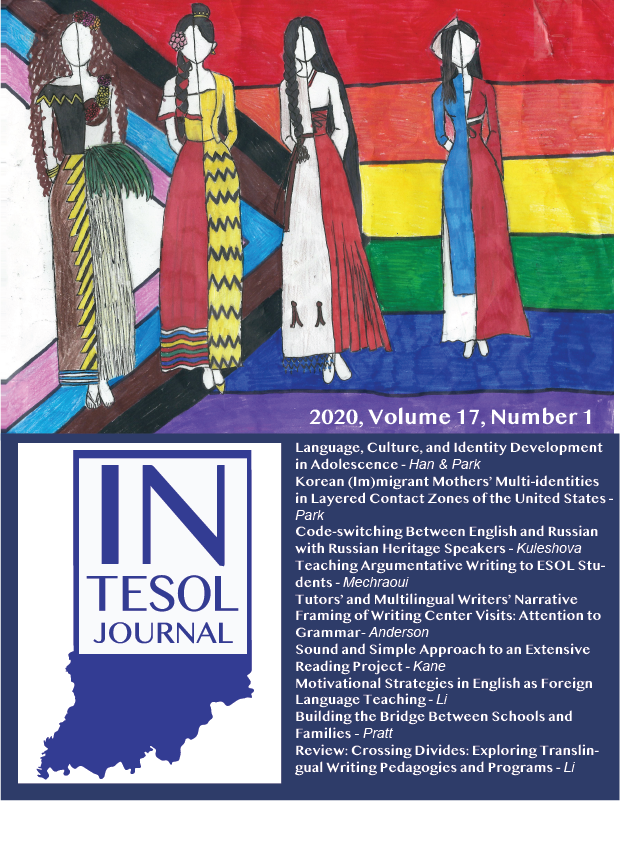Code-switching Between English and Russian with Russian Heritage Speakers, Born and Raised in Russian-speaking Families in the USA
DOI:
https://doi.org/10.18060/24431Keywords:
bilingualism, translanguaging, code-switching, Russian heritage speakers, heritage speakersAbstract
Code-switching is one of the major areas in the field of Bilingualism. Code-switching describes the processes of switching between languages among those who know and speak more than one language. This article will analyze the code-switching between Russian and English in Russian heritage speakers. They are first year students at a large Midwestern university, born in the U.S. to Russian-speaking parents. They have been taking university Russian classes for two semesters. The students were asked to record two five-minute dialogues with their parents who also speak Russian and English. There was neither instruction to use solely Russian, nor the use of English was prohibited. The goal of the research was to count and analyze the instances of code-switching between Russian and English, and prove or reject the hypothesis that there would be fewer code-switching instances in the dialogue devoted to a family holiday versus the dialogue devoted to university classes. The dialogue topics were furnished beforehand, however, no preparation was asked. The speech was asked to be spontaneous and natural. The findings proved the hypothesis that code-switching instances in the first dialogue were less frequent, so the students were mainly using only one language - Russian - without switching to English very often. The second dialogue revealed more code-switching instances as was initially supposed. Conclusions and directions for future research are presented.
References
Carreira, M. & Kagan, O. (2011). The results of the National Heritage Language Survey: Implications for teaching, curriculum design, and professional development. Foreign Language Annals, 44 (1), 40-64. https://doi.org/10.1111/j.1944-9720.2010.01118.x
Dubinina, I. & Polinsky, M. (2013). Русскоговорящие американцы: лингвистические портреты. American Russian: Linguistic Profiles. In: Language in a global context. Язык в глобальном контексте (pp. 95-123). Moscow: INION.
Immigration. Russian/Polish. Library of Congress. Retrieved May, 8, 2020 from https://www.loc.gov/teachers/classroommaterials/presentationsandactivities/presentations/immigration/polish3.html
Isurin, L. (2011). Russian Diaspora: Culture, Identity, and Language Change. De Greyter Mouton.
Heredia, R. R., & Altarriba, J. (2001). Bilingual language mixing: Why do bilinguals code-switch? Current Directions in Psychological Science, 10(5), 164–168. https://doi.org/10.1111/1467-8721.00140
Kopeliyovich, S. (2010). The variety of Russian as a Heritage language in Israel: Hebrew-induced changes at the abstract level. Instrumentarium of Linguistics: Sociolinguistic Approaches to Non-Standard Russian. Helsinki.
Marian, V., & Kaushanskaya, M. (2007). Cross-linguistic transfer and borrowing in bilinguals. Applied Psycholinguistics, 28, 369–390. https:doi.org/10.1017.S014271640707018X
Martinez, A. (2019). Language and Math: What if we have two separate naming systems? Languages, 4(68). https://doi:10.3390/languages4030068
Marsh, L.G., & Maki, R.H. (1976). Efficiency of arithmetic operations in bilinguals as a function of language. Memory & Cognition, 4, 459–64. https://doi: 10.3758/BF03213203
Myers-Scotton, C. (1993). Dueling Languages: Grammatical Structure in Codeswitching Oxford: Clarendon Press.
Naiditch, L. (2000). Code-switching and -mixing in Russian-Hebrew bilinguals. Studies in Slavic and General Linguistics, 28, 277-282. https://www.jstor.org/stable/40997171
Polinsky, Maria. “Heritage Language”. YouTube, uploaded by Serious Science, 30 January 2014, https://www.youtube.com/watch?v=PKtSAirA_T8
Poplack, S. (2004). Code-switching. In U. Ammon, N. Dittmar, K. J. Mattheier and P. Trudgill (Eds.), Sociolinguistics. An international handbook of the science of language and society, 589-596. Berlin: Walter de Gruyter.
Remennick, L. (2009). Russian Immigrants in Israel. Jewish Women: A Comprehensive Historical Encyclopedia. Jewish Women's Archive. https://jwa.org/encyclopedia/article/russian-immigrants-in-israel
Roth, M. (2005). Russian-English code-switching in New York City. Language in Society, 34(3), 485-488. https://www-cambridge-org.ezproxy.lib.purdue.edu/core/services/aop-cambridge-core/content/view/C0FF92A1580DACC91C85939FFC6B5B6A/S0047404505000163a.pdf/russianenglish_codeswitching_in_new_york_city.pdf
Sichyova, O.N. (2005). A note on Russian-English code-switching. World Englishes, 24(4), 487-494.https://onlinelibrary-wiley-com.ezproxy.lib.purdue.edu/doi/epdf/10.1111/j.0883-2919.2005.00432.x
Stavans, A. & Porat, R. (2019). Code-switching in multilingual communities. In S. Montanari & S. Quay. Eds., Multidisciplinary perspectives on multilingualism (pp. 123-148). De Gruyter.
Williams, A., Srivasan, M., Liu, C., Lee, P., & Zhou, Q. (2019). Why do bilinguals code-switch when emotional? Insights from immigrant parent–child interactions. Emotion. Advance online publication. http://dx.doi.org/10.1037/emo0000568
Downloads
Published
Issue
Section
License
Copyright (c) 2020 Deliya Kuleshova

This work is licensed under a Creative Commons Attribution-NonCommercial 4.0 International License.


